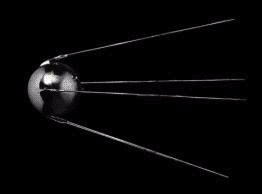Sputnik
 In 1956, there was no such thing as NASA and there was little mention of anything space related. The Americans had plans to launch a 3-pound payload into space but no large funding was concentrated on space.
In 1956, there was no such thing as NASA and there was little mention of anything space related. The Americans had plans to launch a 3-pound payload into space but no large funding was concentrated on space.On October 4th, 1957 the U.S.S.R struck first with the launch of Sputnik I, the world’s first artificial satellite. The 183 pound satellite in its 98 minutes orbits around the earth caught the international community off-guard. The satellite was developed in secrecy to be send into space to humiliate the Americans, check orbit stability, measure temperature inside and outside the satellite, and to check for meteor activity. To detect micro meteors Sputnik was filled with pressurized nitrogen and the temperature meters were meant to detect any piercing. The four whiplike antennas of Sputnik sent all vital information back to Earth and allowed the satellite to be tracked. No meteors strikes were detected on the satellite. The 58 cm-diameter sphere called Sputnik 1 incinerated upon re-entry on January 3rd, 1958. The rocket used to launch Sputnik became the first inter-continental ballistic missile (ICBM) in the world.
Sputnik (and more so the rocket that launched it) brought a scare of nuclear ICBMs to the American public. The government scurried to launch its own satellite and succeeded on February 1st, 1958 with the
With its flight in 1957 Sputnik I got the space race off the ground and into orbit, fueling the way for space exploration in years to follow.
Sources:
http://en.wikipedia.org/wiki/Sputnik_1
http://www.hq.nasa.gov/office/pao/History/sputnik/
http://www.hq.nasa.gov/office/pao/History/sputnik/expinfo.html
